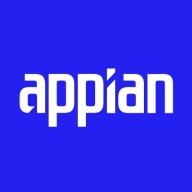

Appian and WorkFusion are both popular choices in the business automation industry. While Appian is preferred for its pricing and support, WorkFusion is recognized for stronger features, making it a competitive option.
Features: Appian enables agile development with a low-code environment that facilitates swift app implementation and robust process management. It supports seamless integration and mobile app features but struggles with customization. WorkFusion focuses on robust RPA and document processing capabilities, offering strong machine learning features for detailed data extraction and automation, making it ideal for technically proficient users.
Room for Improvement: Appian's interface is often criticized for limited customization options and requires developer expertise for certain tasks. It requires improvement in mobile capabilities and integration options. WorkFusion needs to simplify its high technical requirements, catering to advanced Java proficiency, making it challenging for less technical users to adopt without reducing its functionality.
Ease of Deployment and Customer Service: Appian offers a flexible deployment across public cloud, hybrid, and on-premises environments, with high-rated customer service. However, WorkFusion, despite providing diverse deployment options, poses challenges due to its complex setup and demands on infrastructure, but offers a good level of customer service.
Pricing and ROI: Appian's pricing may seem high, but its substantial ROI is realized quickly with rapid deployment. It offers a flexible licensing model to increase productivity. WorkFusion, while competitively priced, eventually shows value in large-scale implementations. Its ROI is witnessed mainly by enterprises capable of utilizing its comprehensive deployment options.
They see return on investment in terms of cost savings, time savings, more efficient processes, and more efficient employees.
Appian is very efficient, allowing us to build a lot of applications within a financial year, making it cost-effective.
The technical support for Appian rates as 10 out of 10 because they have a great support team.
Their customer service is responsive, and the team is very prompt for support.
The technical support is generally good.
They allow sharing of issues faced in use cases and work alongside us to resolve them.
Some issues are resolved quickly, while others might take time as they require further analysis.
Initial support often struggles to find solutions, leading to delays until more experienced personnel get involved.
On a scale of one to 10, Appian rates as a nine for scalability.
Initially, without much coding, I can easily handle five thousand records.
Appian is scalable, but it depends on how you build your applications.
WorkFusion is efficient for structured automation tasks with predefined templates and clear documentation.
The number of bots currently running on the platform should be more than 1,000, including RPA and non-RPA bots.
It depends on how it has been designed and how it has been configured.
The stability of Appian would rate as nine, as it's a stable environment.
WorkFusion requires a strong background in Java to meet requirements effectively.
I frequently face issues with infrastructure and some WorkFusion-related problems, such as login issues.
Some stability problems may arise from processes that have not been designed or coded properly, leading to glitches.
It has room to improve for use cases where the users are public facing, where anonymous users could come to a site and run a business workflow or interact with some data.
I would like to see more enhancement in the user interface to allow more freedom in designing the sites and pages.
If there is a very complex process that includes a lot of data transitioning and memory-centric processes, it consumes a lot of memory.
In low-code automation, most parts are not customizable, particularly when Excel is involved, which increases complexity.
WorkFusion requires a high level of Java knowledge for programming, making it quite technical.
On the pricier side, both Appian and Pega are enterprise-level solutions, placing them on the slightly higher side.
The pricing of Appian is based on the number of users and generally ranges from 70 to 100 USD per user per month.
The price of Appian, on a competitive landscape, is a little bit on the higher side for companies, rating maybe a 6.5.
I am not familiar with the exact pricing, however, it is considered pricey.
It is worth the money as a tool.
Currently, I would rate their pricing around two, as WorkFusion's cloud version seems costly compared to others.
The zero-code integration feature is remarkable, allowing for ease of data transfer and workflow enhancement.
Appian also utilizes AI for business users, providing a feature called process each view, enabling business users to create their own dashboards, reports, and gain insights from their data and processes using artificial intelligence.
I can create tables, perform database-related activities, and create multiple tables.
They provide an inbuilt Selenium framework and infrastructure that eases my workload, allowing me to write Java code and embed it within Groovy classes.
It also supports reusable code components through Java, making it efficient for developers.
The platform now includes auto machine learning and AI capabilities.


Appian is a unified low-code platform and solution used by businesses to build enterprise applications and workflows. This product adapts to the needs of clients and the technologies they are already using to combine their data in a single workflow and maximize resources. The platform has four main components through which it transforms the work process for companies of various sizes. They are:
Appian is utilized across a diverse set of industries, including automotive and manufacturing, energy and utilities, education, financial services, telecom and media, transportation, retail, insurance, healthcare, and life sciences. The most frequent use cases of Appian are customer journey, governance, risk and compliance, operational efficiency, supply chain, distributed order management, and environmental, social, and governance (ESG) management.
Appian Features
Appian has various features that allow users to create solutions for their businesses. These features can be separated into a few groups according to function, including automation, low-code application development, and integrations and data. Some of the most frequently used features of Appian include:
Appian Benefits
The benefits of using Appian include:
Reviews from Real Users
A practice leader - digital process automation at a computer software company values Appian highly because the product is easy to develop, low-code, and has a good user interface.
Alan G., an advisory board member at Codecon VR, Appian offers a clear application life cycle, easy to learn documentation, and comes with a fundamentals course.
WorkFusion, Inc. is the creator of AI-enabled Digital Workers designed specifically for banking and financial services organizations. Its Digital Workers are true knowledge workers that effectively augment existing teams in functions like anti-money laundering (AML), sanctions, customer onboarding, Know Your Customer (KYC), and customer service. WorkFusion’s digital workforce solutions help solve talent shortages, increase workforce capacity, save money, enhance employee and customer satisfaction, and ensure ongoing compliance. For more information visit workfusion.com.
We monitor all Process Automation reviews to prevent fraudulent reviews and keep review quality high. We do not post reviews by company employees or direct competitors. We validate each review for authenticity via cross-reference with LinkedIn, and personal follow-up with the reviewer when necessary.